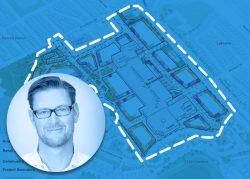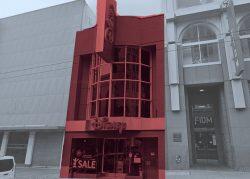The already complicated landscape for San Francisco retail added a wild card with Paris-based Unibail-Rodamco-Westfield recent announcement that it will sell all of its U.S. shopping centers–including its stake in the Westfield San Francisco Centre on Market Street near Union Square and two suburban malls it owns outright in the South Bay.
Mark Mason, senior vice president of investment at Marcus and Millichap in San Francisco, said he was taken aback at the news of the sell off given that Unibail-Rodamco bought Westfield Corporation’s portfolio of 24 malls across the U.S. four years ago for $16 billion.
The same portfolio valued at only $13.2 billion at the end of 2021 and Unibail has said it plans to complete the sale of its U.S. portofolio by 2024 , offering scant details on how it will market the properties in the U.S.
Unibail’s public pronouncement that it wants to unload its U.S. properties as part of a plan to refocus on its retail centers in core markets in Europe going forward took some of the sting out of the announcement.
“Such a wholesale change in such a short period was surprising,” Mason said, but ultimately came down to a global strategy as opposed to a reflection on any local market.
Mason said he anticipates an equally big, and possibly international, player as the most likely buyer of the Bay Area assets, especially the San Francisco Centre, co-owned by Brookfield Properties.
Brookfield did not respond to a request for comment on the San Francisco Centre’s future, but its showing a penchant for reimagining rather running away from retail properties elsewhere in city, The develop is currently in the midst of a years-long planning process on a $2-billion, decades-spanning revamp of Stonestone Galleria, near San Francisco State University, with plans to remake the shopping center and its expansive parking lot into a new neighborhood with the mall at its center and nearly 3,000 for-sale and rental homes, offices and open space surrounding the perimeter of the 41-acre site.
The San Francisco Centre is decidedly different–1.2 million square feet that rises nine stories in a densely packed district. But retail transformations are in the air downtown mall, Mason noted. Several other notable transformations are already planned in the Union Square area, including the former Barney’s flagship at 48 Stockton Street and the Macy’s building directly across from the square, both of which plan to decrease their retail spaces and add office space and, on the upper floors of the Macy’s building, housing.
Unlike either of those properties, which had single owners and single tenants, any entity that buys into the San Franciso Centrewould get numerous leases set to expire one by one. A new owner would also have to work in concert with Brookfield or buy the Toronto-based developer out of its share in order to make a similar transition. The size of the building is another outlier; even the 250,000-square-foot mall IKEA bought for $198 million a few blocks away in the Mid-Market neighborhood is roughly one-fifth the size.
“There is no real comparable asset to it,” Mason said of the San Francisco Centre.
Another unknown? How the Union Square area will recover over the next few years in the absence of the pre-pandemic throng of tourists, a major reduction in business travel and the still-uncertain return of the area’s office workers.
Over the long-term, Mason expects to see Union Square “maintain its status as one of the premier shopping destinations in the nation.” That said, he believes there will likely continue to be downward pressure on the area over the next 18 to 24 months as tourism ramps back up—the same timeframe Unibail Rodamco Westfield will be looking to secure a buyer.
“It’s a tremendous opportunity to buy into this market,” he said. “The next team that comes in to reenvision this asset will be well rewarded.”
Laura Barr, senior vice president of CBRE’s consumer and retail group, said that tourism is integral to Union Square’s success, but that “local spending power shouldn’t be scoffed at.”
“Wherever there’s the potential to capture significant spend, there’s potential for successful retail,” she said.
Local spending power has been centered around neighborhood shopping corridors as the pandemic kept masses of residents closer to home, she said. The trend took a toll on the downtown retail core–a turn that continues to hold true particularly on Mondays and Fridays, as San Francisco settles into a Tuesday-Wednesday-Thursday return-to-office schedule, at least in the initial phases.
CBRE data shows that demand for San Francisco office space went up 31 percent in the first quarter of 2022 compared to the last quarter of 2021, yet market-wide availability increased to a record high of 28.6 percent, following the addition of 1.5 million square feet of newly available space that came to market during the quarter. In Union Square, the vacancy rate was 29% in the first quarter, compared with 22% in the Financial District, 32% South of Market and 41% in Yerba Buena.
People are coming to work downtown, said Barr, but they aren’t necessarily leaving their desks to venture out for lunch in the afternoon or staying downtown after work to get drinks or see a show as much as they had in the past, creating a “chicken and the egg”-type conundrum where one activity is needed to beget another.
“If you know you’re going to see a great concert, you might work the day from the office on a Thursday or Friday when you wouldn’t have otherwise and you might even grab lunch while you’re doing that,” she said. “So we just need to see some of that momentum come back.”
Even without the foot traffic from office workers, Barr said some downtown vendors have been reporting sales that are comparable to their pre-pandemic volume. She added that “a laundry list of luxury tenants” has recently committed to or are expanding their footprint in the area, including Chanel’s $63-million purchase of the four-story Post Street building that currently houses Williams-Sonoma.
“Brands that already exist in San Francisco and know they do well here are doubling down,” she said.
Barr would not comment on how the Westfield’s sale could impact the area’s recovery other than to say that, “There’s no one driver in Union Square.” In fact, it is the interplay of so many factors—restaurants, retail and arts institutions being frequented by a mix of office workers, locals, tourists and business travelers—that made the area vibrant in the past and, Barr hopes, in the future.
“There’s certainly a lot of work that needs to be done, no question,” she said. “But there’s a lot more positive news here than is being publicized and with hard work I think we’ll see really good things to come over the next few years.”
Read more



